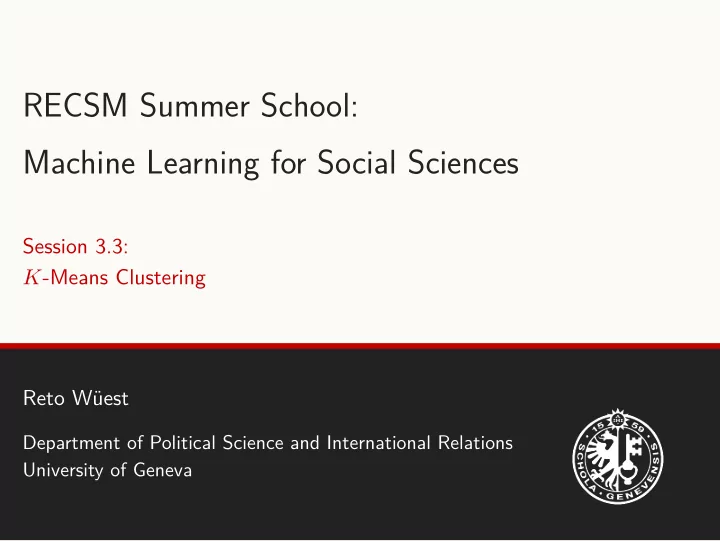

RECSM Summer School: Machine Learning for Social Sciences Session 3.3: K -Means Clustering Reto Wüest Department of Political Science and International Relations University of Geneva 1
Clustering
Clustering • Clustering refers to a set of techniques for finding subgroups, or clusters, in a data set. • The goal is to partition the observations of a data set into distinct groups so that the observations within each group are similar to each other, while the observations in different groups are different from each other. • This is an unsupervised problem because we are trying to discover structure (distinct clusters) on the basis of a data set. 1
Clustering Versus PCA • Both clustering and PCA seek to simplify data via a small number of summaries. • However, their mechanisms are different: • PCA tries to find a low-dimensional representation of the observations that explains a large fraction of the variance; • Clustering tries to find homogeneous subgroups among the observations. 2
K -Means Clustering and Hierarchical Clustering • There are many clustering methods; K -means clustering and hierarchical clustering are the two best-known approaches. • In K -means clustering, we seek to partition the observations into a pre-specified number of clusters. • In hierarchical clustering, we do not know in advance how many clusters we want. • We can cluster observations on the basis of the features in order to identify subgroups among the observations; or we can cluster features on the basis of the observations in order to discover subgroups among the features. 3
Clustering K -Means Clustering
K -Means Clustering • K -means clustering partitions a data set into K distinct, non-overlapping clusters. • We must first specify the desired number of clusters K . • The K -means algorithm then assigns each observation to exactly one of the K clusters. 4
K -Means Clustering – Example Simulated data set with 150 observations in two-dimensional space K=2 K=3 K=4 (The colors of the observations are the output of the clustering algorithm: they indicate the cluster to which each observation was assigned by K -means clustering. Source: James et al. 2013, 387) 5
Details of K -Means Clustering • Let C 1 , . . . , C K denote sets containing the indices of the observations in each cluster. • These sets satisfy two properties: 1 C 1 ∪ C 2 ∪ . . . ∪ C K = { 1 , . . . , n } . In other words, each observation belongs to at least one of the K clusters. 2 C k ∩ C k ′ = ∅ for all k � = k ′ . In other words, no observation belongs to more than one cluster. • The goal is to find a good clustering, i.e., one for which the within-cluster variation is as small as possible. 6
Details of K -Means Clustering • The within-cluster variation W ( C k ) is a measure of the amount by which the observations within cluster C k differ from each other. • We want to partition the observations into K clusters such that the sum of the within-cluster variation is as small as possible: � K � � arg min W ( C k ) . (3.3.1) C 1 ,...,C K k =1 • To solve (3.3.1), we need to define the within-cluster variation W ( C k ) . 7
Details of K -Means Clustering • The most common definition of W ( C k ) is p 1 � � ( x ij − x i ′ j ) 2 , W ( C k ) = (3.3.2) | C k | j =1 i,i ′ ∈ C k where | C k | is the number of observations in cluster C k . • Combining (3.3.1) and (3.3.2) gives the optimization problem in K -means clustering: p K 1 � � � ( x ij − x i ′ j ) 2 arg min . (3.3.3) | C k | C 1 ,...,C K k =1 i,i ′ ∈ C k j =1 8
Details of K -Means Clustering • Solving (3.3.3) is a very difficult problem, since there are many(!) ways to partition n observations into K clusters (unless K and n are small). • However, the following algorithm can be shown to provide a local optimum to the K -means optimization problem. 9
Clustering Algorithm for K -Means Clustering
Algorithm for K -Means Clustering Algorithm: K -Means Clustering 1 Randomly assign a number, from 1 to K , to each of the observations. These serve as initial cluster assignments for the observations. 2 Iterate until the cluster assignments stop changing: (a) For each of the K clusters, compute the cluster centroid. The k th cluster centroid is the vector of the p feature means for the observations in the k th cluster. (b) Assign each observation to the cluster whose centroid is closest (where closest is defined using Euclidean distance, i.e., the “straight-line” distance between two points). 10
Algorithm for K -Means Clustering K -means algorithm run on the simulated data set with 150 observations ( K = 3 ) Data Step 1 Iteration 1, Step 2a Iteration 1, Step 2b Iteration 2, Step 2a Final Results 11 (Source: James et al. 2013, 389)
Algorithm for K -Means Clustering • Because the K -means algorithm finds a local rather than a global optimum, the results obtained will depend on the initial random cluster assignments in Step 1 of the algorithm. • Therefore, it is important to run the algorithm multiple times with different random initial values. • Then one selects the best solution, i.e., that for which the objective (3.3.3) is smallest. 12
Algorithm for K -Means Clustering Local optima obtained by running K -means clustering six times using different initial cluster assignments 320.9 235.8 235.8 235.8 235.8 310.9 (Above each plot is the value of the objective (3.3.3). Source: James 13 et al. 2013, 390)
Recommend
More recommend